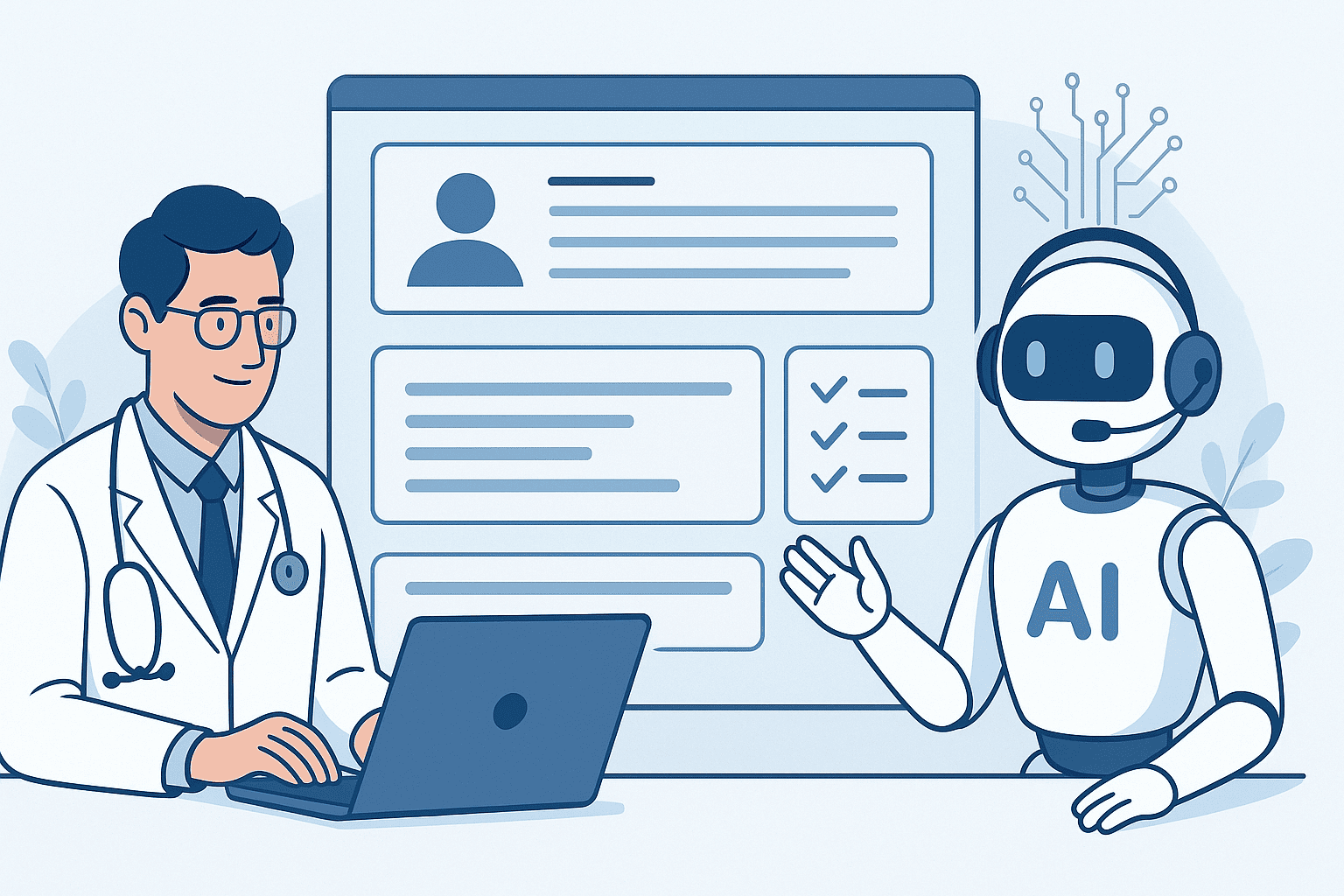Updated on: July 10, 2025
Electronic Health Records (EHRs) have transformed the healthcare industry by digitizing patient data, improving access, and enhancing care coordination. But for many clinicians, EHR systems have also introduced a new challenge: workflow inefficiencies that lead to longer documentation hours, administrative fatigue, and physician burnout.
In this article, we’ll explore:
✅ What EHR workflow means
✅ The common pain points in today’s EHR processes
✅ How AI transcription and Virtual Medical Scribes can optimize EHR workflows
✅ Why DocScrib is the perfect solution for modern healthcare practices
What is EHR Workflow?
EHR workflow refers to the sequence of steps clinicians and healthcare staff follow to:
-
Collect patient information
-
Document care plans
-
Input and retrieve data from the Electronic Health Record (EHR) system
A smooth EHR workflow should help providers:
-
Deliver efficient patient care
-
Meet compliance requirements
-
Minimize administrative time
However, most EHR systems fall short in usability and speed, often overwhelming clinicians with excessive clicks, repetitive data entry, and time-consuming charting.
Why Current EHR Workflows Fall Short
Many healthcare providers face:
-
Documentation overload
-
Long hours spent on charting after clinic
-
Decreased patient interaction due to “screen time”
-
Increased operational costs without matching productivity gains
EHRs like Epic and Cerner offer robust features, but they still rely heavily on manual documentation, which is the root cause of inefficiency.
How AI & Virtual Medical Scribes Improve EHR Workflow
The solution? AI-driven documentation tools and Virtual Medical Scribes that integrate seamlessly with your existing EHR.
Here’s how DocScrib enhances your EHR workflow:
- Real-Time AI Transcription: Our software captures patient-provider conversations and auto-generates clinical notes.
- SOAP Note Structuring: Automatically formats notes into Subjective, Objective, Assessment, and Plan (SOAP) sections.
- Seamless EHR Integration: Pushes completed notes directly into Epic, Cerner, Athenahealth, or other systems.
- Minimal Clinician Input: Allows providers to review and approve notes, saving time and reducing cognitive load.
👉 Ready to see it in action? Schedule a Free Demo
Benefits of Optimizing EHR Workflow with AI
1. Save Time and Boost Efficiency
Clinicians can save 1–2 hours daily by automating note-taking and eliminating redundant data entry.
2. Reduce Burnout
Less time on documentation means lower stress levels and better work-life balance.
3. Improve Documentation Accuracy
AI-driven transcription ensures more consistent, standardized notes, reducing compliance risks.
4. Enhance Patient Care
Clinicians can focus fully on patients, not on computer screens.
5. Lower Operational Costs
AI-powered Virtual Medical Scribes offer a cost-effective alternative to hiring full-time human scribes.
👉 Learn how DocScrib can deliver these benefits: https://docscrib.com/
Practical Use Case: EHR Workflow with DocScrib
Imagine this scenario:
👨⚕️ You walk into the exam room.
🤖 DocScrib’s AI scribe listens unobtrusively and generates a real-time transcript.
📝 By the time the visit ends, the SOAP note is complete, accurate, and ready for your EHR.
✅ You review, click approve, and move to your next patient.
No typing. No wasted time. No burnout.
EHR Workflow Optimization Checklist
| Step | Action |
|---|---|
| Identify Bottlenecks | Map out current EHR processes and highlight time-consuming tasks |
| Leverage AI Transcription | Implement AI-driven tools like DocScrib to automate note-taking |
| Train Staff on AI Tools | Offer training on using Virtual Medical Scribes efficiently |
| Monitor Metrics | Track time savings, clinician satisfaction, and documentation quality |
| Iterate & Improve | Gather feedback and continuously refine the workflow |
👉 Docscrib offers full training and onboarding for smooth AI adoption
Overcoming Common EHR Workflow Challenges
| Challenge | Docscrib Solution |
|---|---|
| Time-consuming charting | Real-time AI transcription automates note generation |
| Inconsistent documentation | Structured, standardized notes every time |
| Clinician burnout | Less time spent typing; more time for care and personal wellbeing |
| Data security concerns | Full HIPAA compliance with secure cloud-based transcription |
The Role of Human-AI Collaboration in EHR Workflow
Remember: AI doesn’t replace clinicians—it augments their capabilities.
With Human-AI Collaboration:
-
The AI handles routine, repetitive tasks (note generation, formatting)
-
Clinicians maintain control, judgment, and oversight
Future Trends in EHR Workflow
The future of healthcare documentation will be:
-
Voice-driven
-
AI-enhanced
-
Seamlessly integrated with EHRs
-
Focused on clinician wellbeing and patient experience
Practices that adopt AI-powered solutions like DocScrib are already ahead of the curve.
Final Thoughts: It’s Time to Fix EHR Workflow
EHRs are here to stay—but the way we use them doesn’t have to stay stuck in the past. By embracing AI transcription software and Virtual Medical Scribes, your organization can:
✅ Save time
✅ Reduce burnout
✅ Improve patient outcomes
✅ Cut documentation costs
Frequently Asked Questions (FAQ)
1. What is EHR workflow optimization?
It refers to streamlining the processes involved in creating, managing, and accessing electronic health records to improve efficiency and reduce clinician burden.
2. How can AI improve EHR workflow?
AI automates time-consuming documentation tasks, freeing clinicians to focus on care while improving note accuracy and consistency.
3. Is AI transcription software secure?
Yes. DocScrib is fully HIPAA-compliant and uses advanced encryption to protect patient data.
4. Does AI replace medical scribes?
No. AI scribes like Docscrib support human clinicians by automating routine documentation while leaving clinical judgment in human hands.
